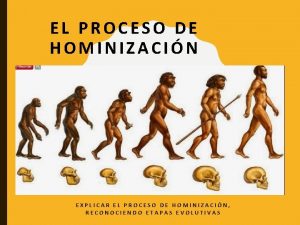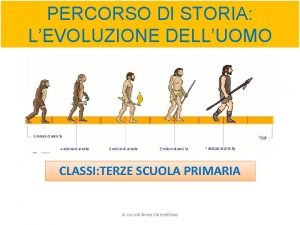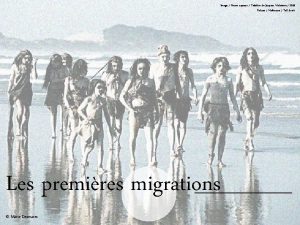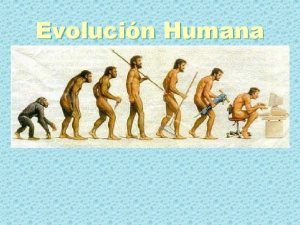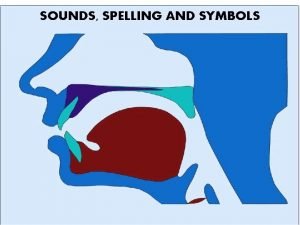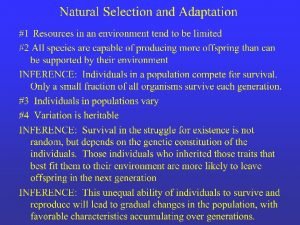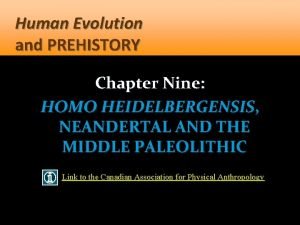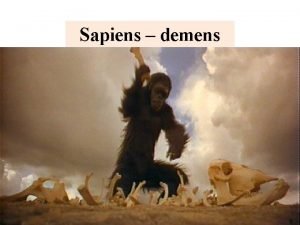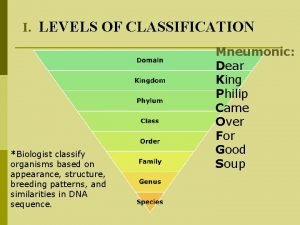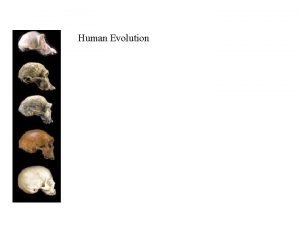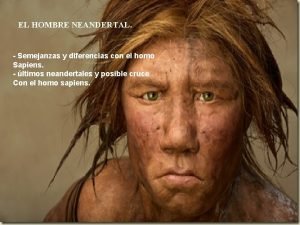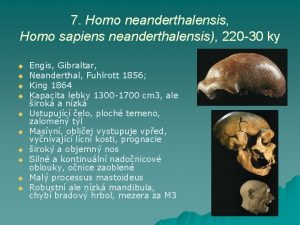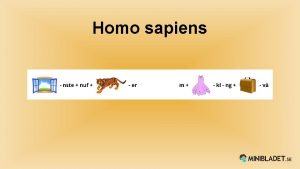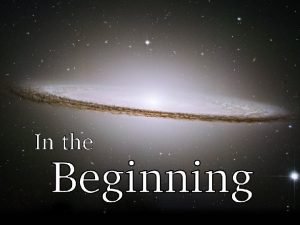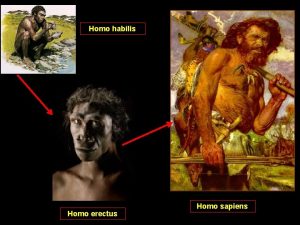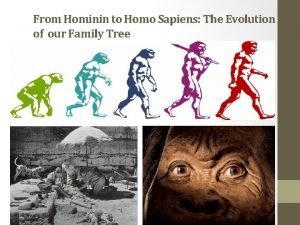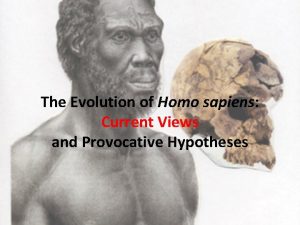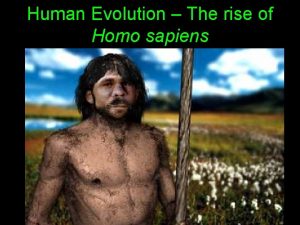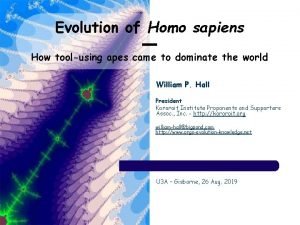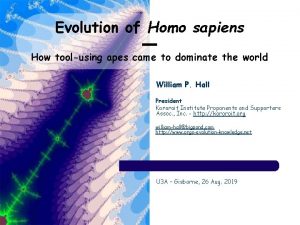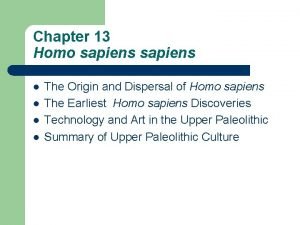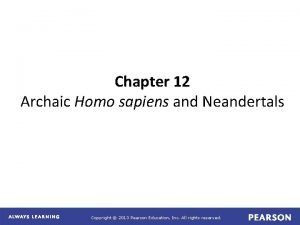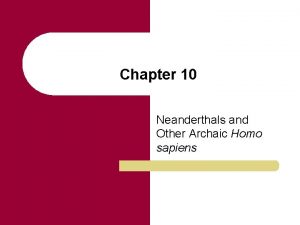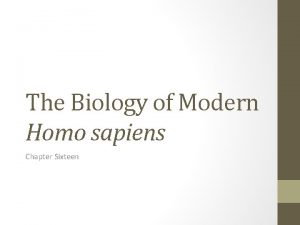The Evolution of Homo sapiens Chapter 15 Homo
























- Slides: 24

The Evolution of Homo sapiens Chapter 15

Homo sapiens • H. sapiens • All contemporary hominin populations • Delicate Crania • Vertical Foreheads • Pyramidal mastoid process • Point of attachment for several muscles • Canine fossa • Depression below the orbital that allows for greater muscle control in non-verbal communication

3 Homo sapiens Variation and distribution Homo sapiens

Questions About the Origin and Dispersal of Modern Humans • When (approximately) did modern humans first appear? • Where did the transition take place? • What was the pace of evolutionary change? How quickly did the transition occur? • How did the dispersal of modern humans to other areas of the Old World (outside of their area of origin) take place?

Homo sapiens • Most paleoanthropologists agree that fossil forms dating back as far as 100, 000 ya should be included in the same fully modern group as modern humans • Models of Human Origins: • Multiregional Evolution • Two “Out-of-Africa” Models

Multiregional Evolution • Populations, connected by gene flow, in Europe, Asia, and Africa continued evolutionary development from archaic H. sapiens to anatomically modern humans • Associated with paleoanthropologist Milford Wolpoff of the University of Michigan

Complete Replacement Model • Proposes anatomically modern populations arose in Africa in the last 200, 000 years • They migrated from Africa, completely replacing premodern populations in Europe and Asia • Does not account for the transition from premodern forms to H. sapiens anywhere except Africa • Developed by British paleoanthropologists Christopher Stringer and Peter Andrews

Partial Replacement Model • Various perspectives suggest that modern humans originated in Africa and then, when their population increased, expanded out of Africa into other areas of the Old World • This model claims that interbreeding occurred between emigrating Africans and resident premodern populations

15 -9 The Origins of Modern Humans

Time Line of Modern Homo Sapiens Discoveries: What do the Data Say?

Early Homo sapiens Discoveries From Africa and the Near East Dates 195, 000 ya Site Hominind Omo H. sapiens Ethiopi a 154, 000 - Herto 160, 000 Ethiopi H. sapiens ya a idaltu Evolutionary Significance Oldest modern human; two crania found, one more modern looking than the other Well-preserved cranium; bestpreserved early modern human found anywhere

Early Homo sapiens Discoveries From Africa and the Near East Dates 115, 000 ya 110, 000 ya Site Hominin Skhul Israel H. sapiens Qafzeh H. Israel sapiens Evolutionary Significance Minimum of 10 individuals; earliest modern humans known outside of Africa Large sample; modern, but some individuals fairly robust; early date

Herto Cranium • Herto cranium from Ethiopia, dated 160, 000– 154, 000 ya. • Adult • Mosaic of modern and premodern traits • Very large and long cranial vault • 1450 cm 3 • Large, arching browridge and projecting occipital protuberance • H. sapiens idaltu • “idaltu” is the Afar word for “elder”

Specimens From Israel • Skhül 5. (a) • 130, 000 -100, 000 ya • Qafzeh 6 (b) • 120, 000 -92, 000 ya • Modern traits • Vault height • Forehead • Lack of prognathism • Contemporary with Neandertals in Region

Key Early Modern Homo sapiens from Europe and Asia Hominin Evolutionary Significance 40, 000 ya Tianyuan Cave Beijing, China H. sapiens Partial skull and a few postcranial bones; oldest modern human find from China 40, 00045, 000 ya Niah Cave Borneo, Indonesia H. Partial skull; oldest sapiens modern human find sapiens from Asia Dates Site

Key Early Modern Homo sapiens from Europe and Asia Dates 30, 000 ya 24, 500 ya Site Cro. Magnon France Abrigo do Lagar Velho Portugal Hominin Evolutionary Significance H. sapiens Most famous early modern human find; earliest evidence of modern humans in France Child’s skeleton; possible hybrid of H. sapiens Neandertal and modern sapiens human, it is controversial

Cro-Magnon I • Cro-Magnon I (France) • European Upper Paleolithic • Approx 40, 000 ya • Modern traits are clear • Robustly built and powerful • Cranial capacity around 1, 600 cc

Neandertal/H. sapiens Admixture • Abrigo do Lagar Velho • “hybrid” child • Recent Genetic comparisons of Neandertal DNA and contemporary humans • Populations outside of Africa typically have more Neandertal DNA • Refutes hypotheses of complete replacement of the Neanderthals by early modern humans

Comparing Skulls Homo Sapiens Neandertals

Homo floresiensis • Indonesian island of Flores in 2004 • Originally dated to 95, 000 to 13, 000 years ago • New estimates until 50, 000 years ago • Archaic Homo survived well into the lifespan of AMH • Taxonomy • Skull slightly smaller than chimpanzees • Stood 3 ft with big feet, stubby big toe • Probably could not run • History • H. erectus arrives in Flores 840, 000 years ago • Controlled fire and used stone tools more sophisticated than H. erectus • Influenced by same evolutionary forces that led to smaller species of elephant on the island

Australia and the New World • Australia • 50, 000 ya modern humans inhabited Sahul • Area including New Guinea and Australia • Kow Swamp 14, 000 -9, 000 ya • Fossils with archaic features • The Americas • Probably populated by Asian hunters following prey across the Bering Strait • Firmest dates in the New World are 13, 500 ya • Dates of up to 27, 900 ya have been suggested

Upper Paleolithic Technology • 50, 000 to 10, 000 ya • Upper Paleolithic is often defined by: • High frequency of stone blades • Bone, antler, ivory, and horn tools were also made • A variety of artistic methods and styles including • Paintings • Engraving • Sculpture

Cave Art • Dated back to 36, 000 years ago • More than a hundred sites, mostly southern France • Lascaux • Limestone walls have absorbed the paintings • Paintings of prey: mammoths, wild cattle, deer, reindeer, horse • Largest animal is 18 feet long • Perhaps pre-hunt ritual • Some portrayed with spears, others pregnant or copulating • Animal fertility ritual? • Hunt history?

The Rise of Civilization • Increase in population • Sumer • Earliest civilization developed in the Middle East • The Bronze Age • Metallurgy was refined • Civilizations arose in other parts of the Old World and independently in parts of the New World
 Linea de tiempo de la hominización
Linea de tiempo de la hominización A cura
A cura Tlfilm
Tlfilm Homo sapiens
Homo sapiens Homo sapiens arcaico
Homo sapiens arcaico Arbol filogenético humano
Arbol filogenético humano He was treated like a ____ and cast out from his community.
He was treated like a ____ and cast out from his community. Homo sapiens spelling
Homo sapiens spelling Homo sapiens taksonomi
Homo sapiens taksonomi Sebutkan tiga ras pokok homo sapiens ! *
Sebutkan tiga ras pokok homo sapiens ! * Homo sapiens
Homo sapiens Homo sapiens
Homo sapiens Whats homo sapiens
Whats homo sapiens Evolucin
Evolucin Caracteristicas fisicas de homo sapiens
Caracteristicas fisicas de homo sapiens O que é homo sapiens
O que é homo sapiens O que é homo sapiens
O que é homo sapiens Homo sapiens kingdom
Homo sapiens kingdom Levels of taxonomy
Levels of taxonomy Paranthropus boisei
Paranthropus boisei Similitudes entre neandertal y sapiens
Similitudes entre neandertal y sapiens Saccopastore
Saccopastore Weebly geschiedenis virgo sapiens
Weebly geschiedenis virgo sapiens Memoria concreet 5 oplossingen
Memoria concreet 5 oplossingen Terra p dosimeters ecotest
Terra p dosimeters ecotest
